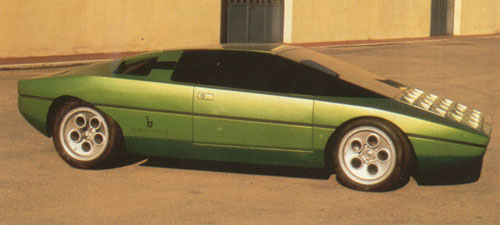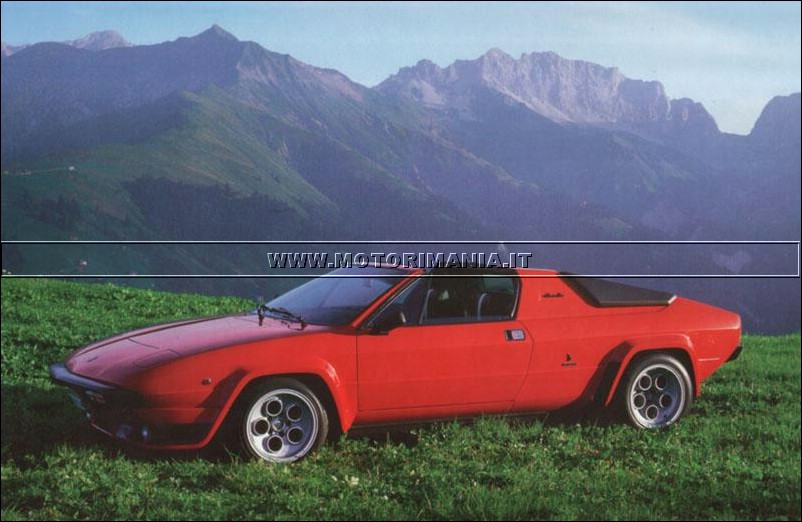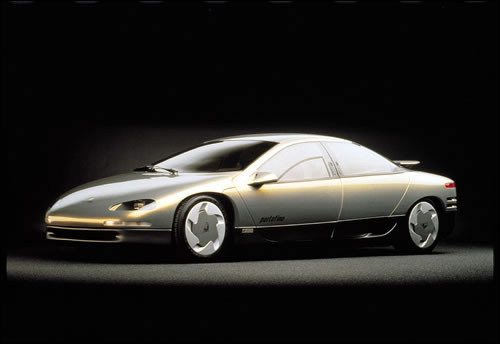Models
HOME |
OVERVIEW |
MODELS |
PHOTOS |
lamborghini.com
 350 GTV
350 GTV
The Lamborghini 350 GTV was the prototype and forerunner of the later 350 GT (Lamborghini´s first production model).
It featured a controversial semi-fastback body design by Franco Scaglione, which was modified for series production by Carrozzeria Touring, and Lamborghini's own 3.5 liter V-12 engine. The car was presented to the public on the 1963 Turin Auto Show.
 Miura
Miura
The Lamborghini Miura is a sports car built in Italy by Lamborghini between 1966 and 1973. A mid-engined layout had been used successfully in competition, including by the Ford GT40 and Ferrari 250 LM at Le Mans. De Tomaso had produced a road car with this layout, the Vallelunga, but otherwise cars designed for the road were almost uniformly front-engined, rear drive vehicles. The Miura was a trendsetter, the one that made the mid-engined layout de rigueur among two-seater high performance supercars. It is named after the Spanish ranch Miura, whose bulls have a proverbial attack instinct.
 Flying Star
Flying Star
The Lamborghini Flying Star II was a prototype concept car built by Carrozzeria Touring in 1966 on a Lamborghini front engine chassis.
With the Flying Star II Carrozzeria Touring, desperately starving for commissions at the time, tried to arouse the interest of Lamborghini. The car had an aluminum V12 engine, 5 speed transmission, fully independent suspension and disc brakes all around. Unfortunately, its large size for a two-seater, angular lines, and controversial roof design made it look like a station wagon. Lamborghini decided to stay with its current 350GT/400GT models. This would be the last design to come out of Carrozzeria Touring before the company closed its doors.
 Marzal
Marzal
The Lamborghini Marzal was a prototype concept car presented by Lamborghini at the 1967 Turin Motor Show.
Designed by Marcello Gandini of Bertone, it was created to supply Ferruccio Lamborghini with a true four-seater car for his lineup which already included the 400GT 2+2 and the Miura. It was distinguished by amply glazed gullwing-doors and an equally amply louvered rear window. Propulsion was by a 2L 175 bhp (130 kW) in-line six engine, actually a split-in-half version of Lamborghini's 4L V12, mated to a five speed transmission.
The Marzal remained a one-off, though the general shape and many of the ideas would go on to be used in the Espada. The Marzal design probably found wider recognition as a die-cast model by Matchbox, albeit in orange livery, although the original show car was painted in silver. This car was driven only once by Princess Grace and her husband as the Monaco Grand-Prix pace car the same year it was designed
 Islero GT
Islero GT
The Lamborghini Islero is a sports car produced by Italian automaker Lamborghini between 1968 and 1969. It was the replacement for the 400GT and featured the Lamborghini V12 engine. The car debuted at the 1968 Geneva Auto Show.
 Espada
Espada
The Lamborghini Espada is a grand tourer which was built by Italian car manufacturer Lamborghini between 1968 and 1978.
Based on the Marzal show car, displayed at the 1967 Geneva Auto Show, and the Bertone Pirana, a radically rebodied Jaguar E-type. It was to fill the spot of a true four seat car in Lamborghini's lineup, which already included the 400GT and Miura. 1217 cars were made, making it the most successful Lamborghini model at the time.
The car was designed by Marcello Gandini of Bertone. The name "Espada" means "sword" in Spanish, referring to the sword that bullfighters use to kill the bulls.
The Espada was originally fitted with a 4L 325 bhp (242 kW) V12 engine, fully independent suspension and four wheel disc brakes. Most transmissions were manual, and the Espada also introduced one of the first automatic transmissions able to absorb the torque of a large sporting V12. It had unusual gearing, with 3 ratios: drive, 1 and reverse.
 Jarama 400 GT
Jarama 400 GT
The Jarama (pronounced Yah-RAH-mah) was named for a district in Spain renowned for breeding fighting bulls, and not for the F1 track outside Madrid as many believe. It was first introduced to the public in the spring of 1970 at the Geneva Motor Show. Styling by Bertone's Marcello Gandini resulted in a roomy, glassy coupe deliberately unspectacular, maybe even somewhat mediocre in design but one that surely must have had some influence on the later Toyota Celica/Supra line and MVS Venturi.
Although the body was designed and pressed by Bertone at its Grugliasco factory, final assembly continued in the hands of Marazzi. The Jarama was built on a shortened version of the Espada's sheet steel platform that Bertone was still building for Lamborghini. The Jarama chassis was shortened by 10.6 inches but the rest of the engine and running gear were virtually untouched. Remarkably though, the Jarama weighed in as one of the heaviest Lamborghini's ever built even with the missing midsection.
The Jarama was as magnificent as any with plenty of performance and even wider, stickier Michelin tyres on Miura wheels to transfer the power to the road to a claimed maximum of 162mph. The excessive weight at 1540kg (3388lbs) made fuel consumption quite excessive. It was a fast, easy-to-drive and comfortable car to drive over long distances and stable even at high speeds. The rear seat provided ample head and legroom and the folding rear seats gave plenty of extra cargo room if needed.
 Urraco
Urraco
The Lamborghini P250 Urraco (pronounced "oo-RAH-koh"), meaning "little bull," was named for the fighting bull which killed the toreadore Manolete. This car was introduced to the public in 1970 at the Turin auto show, though it wouldn't become available to the public until 1973.
The Urraco was developed as an affordable entry level exotic for higher production volume to compete directly with Ferrari's Dino and the Maserati Merak. It's 2+2 layout housed a smaller 2.5 litre V8 engine of completely new design by Paolo Stanzini, positioned transversely just ahead of the rear wheels with the transmission mounted directly beside it. It's new chassis was a sheet steel unibody structure similar to the Espada. Front suspension components bolted directly to this structure while the rear supension and engine/transmission were mounted to a subframe that bolted directly to the chassis from underneath. This made for better access to either engine or transmission for any work more involved than simple servicing.
 countach
countach
The Countach (in Italian, Piemonte local language, the right pronunciation is KOON-tuck, in English most commonly pronounced KOON-tash) series of Lamborghinis were among the most remarkable cars of their time. Their striking appearance, extreme performance and outrageous price tag placed this car in a class of its own. Production spanned some 16 years and 1997 cars in various forms making it a legend that was difficult for Lamborghini to top.
 Bravo
Bravo
The Lamborghini Bravo was a concept car designed by Bertone for Lamborghini. It was first presented in 1974 at the Turin Auto Show.
The Bravo was designed to showcase ideas for a replacement to the Urraco. The completely working prototype featured a 3L 300 hp (220 kW) V8 that powered the rear wheels, and underwent nearly 40,000 miles (64,000 km) of testing before it was placed in the Bertone museum.[1] It was never put into production, but many styling features of the Bravo would find their way into the Countach, including the angular features, the window arrangement, and the wheel design, but the interior was never more than what was barely necessary to operate the vehicle.
 Silhouette
Silhouette
The Lamborghini Silhouette was a mid-engine rear drive sports car made in small numbers by Lamborghini between 1976 and 1979.[1] The Silhouette began as a styling exercise by noted Italian carrozzeria Bertone. It was based on the earlier Lamborghini Urraco but was distinguished from the Uracco by more angular styling. The Silhouette was the first Lamborghini to employ a targa top roof. The Silhouette later evolved into the similar looking but more successful Lamborghini Jalpa. The car had a 3 litre V8 engine mounted transversely behind the driver. Of the 55 of these cars built, 31 are currently known to exist.[1]
Afterwards once the car stopped production it was named and was the only Lamborghini to be named after the project stopped it is also known to be the car which inspired the very popular car of today such as LP640, Murcialago, Gallardo and the upcoming Lamborghini SS 2500
 Cheetah
Cheetah
The Lamborghini Cheetah was Lamborghini's first attempt at an off-road vehicle. It was built on contract from Mobility Technology International, which in turn was contracted by the US military to design and build a new all-terrain vehicle. The basis of the design came from MTI, and was largely a copy of FMC's XR 311 prototype developed for the military in 1970. This resulted in legal action from FMC against MTI and Lamborghini in 1977 when the Cheetah was presented at the Geneva Auto Show. The XR 311 and Cheetah could be considered progenitors of the current Humvee.
The Cheetah was built in San José, California. After initial construction, the prototype was sent to Sant'Agata so Lamborghini could put on the finishing touches. They decided to go with a large, waterproofed 180 bhp (134 kW) 5.9L Chrysler engine, rear mounted, with a 3 speed automatic transmission. The body was fiberglass, and inside there was enough room for four fully equipped soldiers as well as the driver.
 Athon
Athon
ATHON (AH-tawn): "Hymn to the sun" the name is taken from Egyptian Pharaoh Amenhotep IV, husband of Nefertiti, introduced the cult of Athon (solar monotheism) in 1377 - 1358 B.C.
Introduced at the 1980 Turin Motor Show, this 2 seat roadster was designed by Marc Deschamps of Bertone and built on a Silhouette chassis. It was built as a statement of support for Lamborghini who were experiencing financial troubles at the time. Built in a very short time on a limited budget the design succeeded in its purpose for being specular but superficial.
The car is completely open with not even a convertible roof for protection from the elements. The electronic readouts on this dash remind one of the brief facination with electronics the typified early eighties showcars and many production vehicles. Notice how the steering wheel blends into the rest on the dash.
The Athon is still in the posession of Bertone and resides in their company museum in Italy.
 LM
LM
The Lamborghini LM002 is an SUV that was built by the Lamborghini automobile company between 1986 and 1993. Also known as the Rambo, approximately 300 vehicles are thought to have been built. This was an unusual departure for Lamborghini who, until that point was primarily known for high-performance grand tourers and supercars.
 Jalpa
Jalpa
The Lamborghini Jalpa , pronounced in the Spanish "HAL-pah", was a car produced by the Italian automaker Lamborghini from 1981 to 1988. The Jalpa was a development of the earlier Silhouette, but was rather more successful; a total of 419 examples were sold. The Jalpa was intended to fill a role as a more "affordable" Lamborghini, being much cheaper than the Countach. Instead of the big car's V12, the Jalpa was fitted with a transversely-mounted 3.5 litre V8 that developed 255 hp. The bodywork was designed and built by Bertone.
 LMA
LMA
Introduced at the 1982 Geneva Motor Show. This car is obviously an early LM002. Note the early dash, poor seating and more rounded tranmission tunnel. This model was later renamed LM002.
This car no longer exists.
 Portofino
Portofino
1987 introduced a new Lamborghini at the Frankfurt show after the company's takeover by Chrysler. The Portofino was a four door, four seater with vertically opening doors in true Lamborhini fashion. The car was developed at Chrysler Pacifica in Carlsbad, California but was built on a lengthened Jalpa chassis by Coggiola of Turin, Italy. It was quite drivable and was tested by many popular car magazines at the time.
The styling never did make it into production as a Lamborghini which is a shame. Enough praise was showered on the design that it was eventually modified to became the successfull Chrysler Intrepid/Concord series. The unique doors, the best part of the whole design, wouldn't make it into production, though, no doubt due to the lack of B-pillars which serve to strengthen the passenger cage reducing intrusion in side impacts.
The beautiful exterior color would also later turn up as Char-Gold in the available optional colors on the Intrepid/Concord. The inovative rear wing wouldn't be found on these cars, though it did find its way onto the Stealth.
The interior of the Portofino was finished in a beautiful three shades of textured blue leather with yellow piping and accents on the steering wheel and shift knob. A central console divided the passenger compartment adding stiffness to the structure and providing a comfortable wrap-around feeling in the rear seats. The beautiful dash and console layout would influence that of the Diablo being designed about this time.
The hood badge was unique to this single car and consisted of a Lamborghini bull stamped into a brushed metal pentastar.
Sadly the Portofino was destroyed in a transporter rollover in early 1991 but Chrysler, realizing the importance of the car's design in its company's history, saw to it that the car was restored. Only one Portofino was built and it is still in the hands of Chrysler. As of 1999 it is on permanent display at the Daimler/Chrysler World Headquarters and Tech Center in Auburn Hills, Michigan.
July 2006 - The Chrysler/Lamborghini Portofino Concept Car is not demolished. All the chatter on the various Lamborghini web sites was false. The car has been removed from display (as part of the rotating collection) and is currently in storage. It is not damaged.
 Diablo
Diablo
The Countach series of Lamborghinis were a tough act to follow, but Lamborghini managed to put it off in fine style with its replacement Diablo. The Diablo easliy won over many with its softer lines and traditional upswinging doors. Production topped over 3000 units over some 11 years in various forms placing it firmly next to the Countach as a legend in the exotic car world.
 Cala
Cala
Italdesign Cala or probably as it is more commonly referred to, the Lamborghini Cala, was a concept car designed for Lamborghini by Italdesign Giugiaro. It was first shown at the 1995 Geneva Motor Show. It was a completely functional prototype that never made it into production.
The Cala was designed to fill Lamborghini's need for a replacement for the Jalpa, of which production was discontinued in 1988, at the behest of then owners of the company, Chrysler. In 1994 Chrysler sold Lamborghini to Megatech, the Cala design took shape, but when Megatech sold Lamborghini to the Volkswagen Group in 1998, the concept was shelved. The Jalpa replacement would not be found in Lamborghini's lineup until 2003, with the release of the Lamborghini Gallardo.
The Cala was powered by a mid-mounted V10 engine, which produced 400 hp (300 kW), mated to a 6 speed transmission that drove the rear wheels. Top speed was estimated at 180 mph (290 km/h).
 Murcielago
Murcielago
The Lamborghini Murciélago is a supercar produced by a Italian automaker Automobili Lamborghini S.p.A. and designed by Luc Donckerwolke. It was introduced in 2002 as the successor to the Diablo. The Murciélago is a two-door, two-seat coupé. To celebrate the company's 40 years in operation, 50 special edition Murciélagos were built during the autumn of 2003.
An open-top version called the Murciélago Roadster was introduced in 2004 for the 2005 model year. The roadster features similar performance to the coupé with a more aggressive rear flank, as well as a considerably higher price tag.
The Murciélago sports a 6.2 L version of the legendary Lamborghini V12 engine, a six-speed manual or six-speed sequential automatic transmission, and four-wheel drive. It also has a rear spoiler that can be raised to an angle of 70 degrees, side mirrors that fold in to improve aerodynamics, and side scoops that automatically open to the needed size to let in just the right amount of air needed to cool its engine.
 Gallardo
Gallardo
The Lamborghini Gallardo is the Italian supercar maker Lamborghini's "entry-level" supercar (owned by German Audi), sitting beneath the Murciélago. It is also the first car to feature the new Lamborghini V10 engine - only the third engine made by the firm. 5,000 Gallardos were built in just three years, making it the company's most-produced model to date.[1] The second-place Diablo took a decade to sell 2,903 units.
The car is named after a famous breed of fighting bull. Gallardo is also Spanish for the word gallant.
 Concept S
Concept S
The Lamborghini Concept S is a concept car designed by Luc Donckerwolke, the head of Lamborghini design, using the Lamborghini Gallardo as a basis. Shown at the 2005 Geneva Motor Show. It was intended to be a modern interpretation of the single-seat roadsters of the past. Utilizing a 'saute-vent' (French for 'change wind') instead of a traditional windscreen, and dividing the interior into two distinct compartments by continuing the bodywork between the seats, which also serves as an air inlet feeding the mid-mounted 5L V10 engine, gives the car a distinctly futuristic look. The rearview mirror is even electronically retractable to allow the driver to see behind, when necessary, or hide it when not in use. Though considered more of a styling exercise than a working production vehicle, the final working show car only had to be modified slightly from the original computer aided designs. Lamborghini has announced that it will be put into limited production and available for sale sometime in 2007.






















